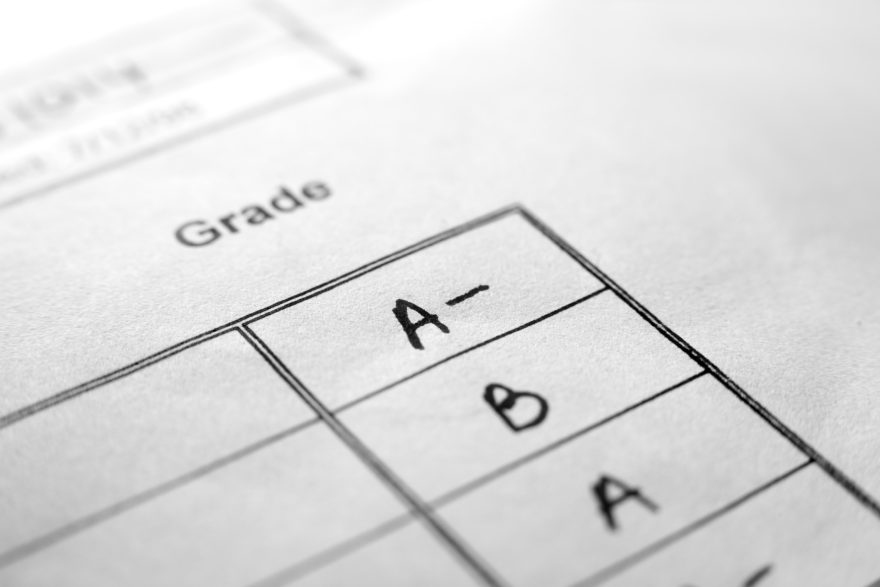- Blog
- > College Admissions
Do Colleges Look at Weighted or Unweighted GPAs?
- Dr. Rachel Rubin
- | December 5, 2024

Grades are often considered the single most important factor in college admissions decisions. But how do colleges compare students who come from such different high schools? You probably know your grade point average (GPA); it’s usually printed on your transcript. But what will that number mean to colleges? And what does it mean for a GPA to be weighted or unweighted?
While there are many ways to calculate a GPA, there are two major camps that are crucial to understand in the college admissions process. One is an unweighted GPA, which calculates your overall average grade out of 4.0, without regarding course difficulty. The other is a weighted GPA, which reflects both grades and course levels.
So, which is more important? When evaluating a high school student’s academic performance, college admissions committees read weighted and unweighted GPAs differently. Read on to learn more about GPA weighting and how admissions officers evaluate your GPAs in the context of applications.
What Is an Unweighted GPA in High School?
An unweighted GPA is simple to calculate. Each final course grade that you receive (from F to A) corresponds to a grade point out of 4.0, as shown in the table below:
| Letter Grade | Percent Grade | Grade Point |
| A+ | 97-100 | 4.0 |
| A | 93-96 | 4.0 |
| A- | 90-92 | 3.7 |
| B+ | 87-89 | 3.3 |
| B | 83-86 | 3.0 |
| B- | 80-82 | 2.7 |
| C+ | 77-79 | 2.3 |
| C | 73-76 | 2.0 |
| C- | 70-72 | 1.7 |
| D+ | 67-69 | 1.3 |
| D | 65-66 | 1.0 |
| E/F | Below 65 | 0.0 |
Note first that an unweighted GPA cannot average to more than 4.0, which means that there is no mathematical difference between an A and an A+ in unweighted GPAs. Furthermore, not all schools offer A+ as a grade, so colleges treat it as identical to an A in unweighted GPAs. Similarly, most colleges consider anything below a D to be a failing grade, so if your school does offer the D- grade, know that it will probably be treated the same as an F.
Second, notice that an unweighted GPA does not take into account the level of the classes you are taking. Under this system, an A- in an honors or Advanced Placement (AP) course is the same 3.7 as an A- in a lower-level class. This erasure is a frequent source of criticism toward the unweighted GPA and a reason why many high schools use a weighted GPA instead. Students and parents want their GPAs to reflect the difficulty of their course load in addition to their grades. However, colleges do not just look at your unweighted GPA. College admissions committees calculate the rigor of your classes, so even if they do care about your unweighted GPA, colleges will also always take the rigor of your classes into consideration.
In other words, for college admissions, you should aim to earn the highest unweighted GPA and the highest level of rigor (by taking the most honors and AP classes that you can).
What Is a Good Unweighted GPA?
A high school transcript that contains an even mix of As and A-s will produce a GPA of 3.85, exactly halfway between the 3.7/A- and the 4.0/A. More As than A-s will come out to a GPA of 3.9 and above, which is generally considered a very high GPA. Having above a 3.9 unweighted is generally the GPA Ivy League schools are looking for. Please keep in mind that top schools expect you to earn this GPA while taking the highest level of classes available at your school and building an impressive resume. More A-s than As will result in a GPA near or below 3.8, which will help students get into highly-ranked schools but not those near the top of the rankings.
A transcript with a mix of A-s and B+s will produce a grade point average in the range of 3.5, which is an important cutoff for many colleges. In general, admissions officers want to see more As than Bs, so having an unweighted GPA of above 3.5 can make a big difference. A GPA below 3.5 indicates to colleges that you have more Bs than As, and anything below 3.2 suggests that you may have some Cs in the mix, too, which will be a red flag for many schools.
That said, even if your high school uses an unweighted GPA, colleges absolutely pay attention to how many honors and AP classes you are taking and the difficulty level of your overall courseload. Thus, even if your GPA is lower than a peer who is taking all regular classes, you will still be the more competitive applicant if you’re taking more honors and AP classes. The key is balance: take challenging courses, but don’t ruin your GPA by taking classes that are too challenging for you. No number of challenging classes can make up for a poor unweighted GPA, so it is crucial to find the balance of honors and AP classes that is right for you!
What Is a Weighted GPA?
A weighted GPA, on the other hand, is a figure that purports to represent both how well you did in each class and the overall difficulty level of the courses you took. The trouble with weighted GPAs is that every high school calculates them differently. The most common GPA scale is one in which any grade in an advanced class is increased by a full grade point, as shown in the table below. However, while the 5.0 scale is common, high schools are also known to employ a GPA scale out of 4.5, 6.0, 9.0, or 10.0, among others.
| Letter Grade | Percent Grade | Honors/AP Level GP | Standard Level GP |
| A+ | 97-100 | 5.3 | 4.0 |
| A | 93-96 | 5.0 | 4.0 |
| A- | 90-92 | 4.7 | 3.7 |
| B+ | 87-89 | 4.3 | 3.3 |
| B | 83-86 | 4.0 | 3.0 |
| B- | 80-82 | 3.7 | 2.7 |
| C+ | 77-79 | 3.3 | 2.3 |
| C | 73-76 | 3.0 | 2.0 |
| C- | 70-72 | 2.7 | 1.7 |
| D+ | 67-69 | 2.3 | 1.3 |
| D | 65-66 | 2.0 | 1.0 |
| E/F | Below 65 | 0.0 | 0.0 |
With a weighted GPA scale, regardless of the upper limit, an A student will have a higher GPA than 4.0. Any grade point average above 4.0 will indicate to colleges that the high school uses a weighted GPA scale, as such a number is impossible in an unweighted system.
What Is a Good Weighted GPA?
That question is extremely hard to answer because of the variance in GPA scales used by different high schools, as well as the different class levels available at different high schools. In general, a student aiming for the most selective colleges should aim to have a GPA as close to the maximum as they can manage. That is, if the GPA scale is out of 4.5, they should have a 4.4 or higher, a 4.9 or higher for a 5.0 scale, and so on. Just as with unweighted GPAs, admissions officers are looking for good grades in honors, advanced, and AP courses.
Sometimes, weighted GPAs can be hard to understand because different high schools may weigh honors courses differently or cap how many AP courses a student can take. If you have questions about how your high school weights its GPAs, you can always talk to your guidance counselor or another school official. This way you can calculate your weighted GPA—giving you a clearer picture of your academic standing.
Related Article: What Is a Good GPA in High School?
Spark Admissions has the highest college admissions success rate in the country
Schedule A Free Consultation with an Admissions Expert
Schedule NowWhich Do Colleges Look At: Weighted vs. Unweighted GPA?
First, know that admissions committees are not fooled by weighted GPAs! Based on school reports, conversations with guidance counselors, and previous knowledge of the applicant’s high school, admissions officers know whether they’re looking at a weighted or unweighted GPA and will only compare like with like. So, if your school provides only an unweighted GPA, your 3.9 will look better than a 4.3 weighted GPA.
In fact, to get around this, many educational institutions actually recalculate all applicant’s GPAs so that everyone starts from the same page: an unweighted GPA of just major courses (i.e., science, math, English, history, computer science, and foreign language). This approach excludes non-academic classes like physical education from the academic evaluation. By doing so, admissions committees can more easily compare applicants’ GPAs before further examining how many challenging courses the student took.
Another thing colleges sometimes ask about is class rank, which is determined by GPA. Class rank used to play a big role in college admissions, but more recently it has fallen out of favor. Many educators argue that ranking fosters cutthroat competition among students, when in fact precise enumeration does not mean as much to colleges as overall academic performance. For this reason, many high schools now report decile instead of rank, while some provide no comparative measure between students at all. Rankings that use weighted GPAs reflect students’ efforts in challenging classes, while those using unweighted GPAs do not.
Additionally, know that most colleges do not have official GPA requirements for admission, because grades can vary so much by student and by high school. The GPA is a starting point for college admissions officers to begin evaluating a student’s overall academic performance, but it is not the only factor impacting your chances of admission. They always seek to contextualize those grades in your larger profile.
Strategies for Improving Weighted and Unweighted GPAs
Whether your goal is to boost your weighted GPA, unweighted GPA, or both, having a clear strategy can help you achieve your academic goals and strengthen your college applications.
1. Select Courses Strategically
For Weighted GPAs: Choose advanced courses like AP, IB, or honors classes to maximize the GPA boost that weighted grading scales offer. Focus on subjects where you have a strong interest and aptitude to excel in these challenging classes.
For Unweighted GPAs: Avoid overloading your schedule with courses of a high difficulty level that may negatively impact your grades. Balance rigorous classes with standard-level ones where you can confidently earn high marks.
2. Master Time Management
Effective time management allows you to handle the demands of rigorous coursework without sacrificing grades, especially when you are taking college-level courses like AP classes. Use planners, apps, or school resources to stay on top of assignments, tests, and projects. Allocating time for review sessions and extra practice can help maintain strong performance across all subjects.
3. Seek Help Early and Build Relationships with Teachers
Struggling in a class? Don’t wait until your grades slip. Reach out to teachers, peers, or tutors for assistance. For challenging advanced courses, forming a study group or attending extra-help sessions will make a significant difference.
Developing relationships with teachers can provide access to valuable support, such as personalized feedback, recommendations for improvement, or extra credit opportunities.
4. Focus on Quality over Quantity
Taking numerous advanced classes might seem appealing, but spreading yourself too thin can harm your overall GPA. Aim for a manageable workload that allows you to perform well rather than risking lower grades by overcommitting.
5. Develop Strong Study Habits
Consistency is key. Create a study routine that includes:
- Reviewing class material daily to reinforce learning.
- Practicing test-taking skills for advanced courses.
- Using tools like flashcards, study guides, or online resources tailored to your classes.
6. Set Goals and Commit to Them
Set academic goals for each semester and reward yourself for achieving them. If setbacks occur, treat them as learning experiences. College admissions officers value upward trends, so consistent improvement over time is key.
GPA Calculation Tools and Resources for Students
In addition to the reference tables above, here are some online tools, resources, and apps that can help you track and improve your GPA as you prepare to apply to your dream school.
Online GPA Calculators
Online GPA calculators are a convenient way to compute your GPA without manual calculations. These tools allow you to input your grades, credit hours, and course levels to generate an accurate GPA. Many calculators even offer separate options for weighted and unweighted GPAs, making it easy to see how challenging courses impact your score.
- GPACalculator.net: A versatile tool that includes advanced features like semester-specific GPA calculations and cumulative GPA tracking.
- Student GPAs Weighted Calculator: Perfect for determining the effects of honors, AP, or IB courses on your weighted GPA.
School-Provided GPA Tools
Explore GPA tracking tools offered by your high school through student portals, which often provide detailed breakdowns of grades, weighted scores, and semester trends. Reach out to your school counselor or academic advisor to find out what resources are available to help you stay on top of your academic progress.
Mobile Apps for GPA Tracking
- My Study Life: A planner and GPA tracker that integrates with your academic schedule.
- Grades by Tapity: An iOS app specifically designed to help students monitor grades and calculate GPAs.
Related Article: Cumulative GPA vs Weighted GPA
A Strong GPA Matters but Won’t Define Your College Admission Chances
Finally, remember that while your weighted or unweighted GPA matters, the rest of your college application is also extremely important. In addition to your GPA, admissions officers will look at your standardized test scores, college essays, extracurricular activities, leadership and community involvement, and scores on AP exams (not just the grade in the class). College admissions is a largely holistic process, so any one factor can offset another. For example, if you have a very high GPA but somewhat lower test scores, that can signal to colleges that you’re smart but not a stellar test-taker. Vice versa, and they know you have innate intelligence but may struggle in certain classroom settings.
Overall, knowing where your cumulative grade point average falls relative to college admissions officers’ expectations is critical in navigating the college admissions process, whether creating a balanced list of schools to apply to, knowing what courses to take at your high school, or strategizing about how much time you should spend on schoolwork versus extracurricular activities. Wondering how you can start getting better grades in high school? Most colleges take all your grades into account, including the ones from your senior year, so it’s never too late to move the needle when it comes to your academic performance!


